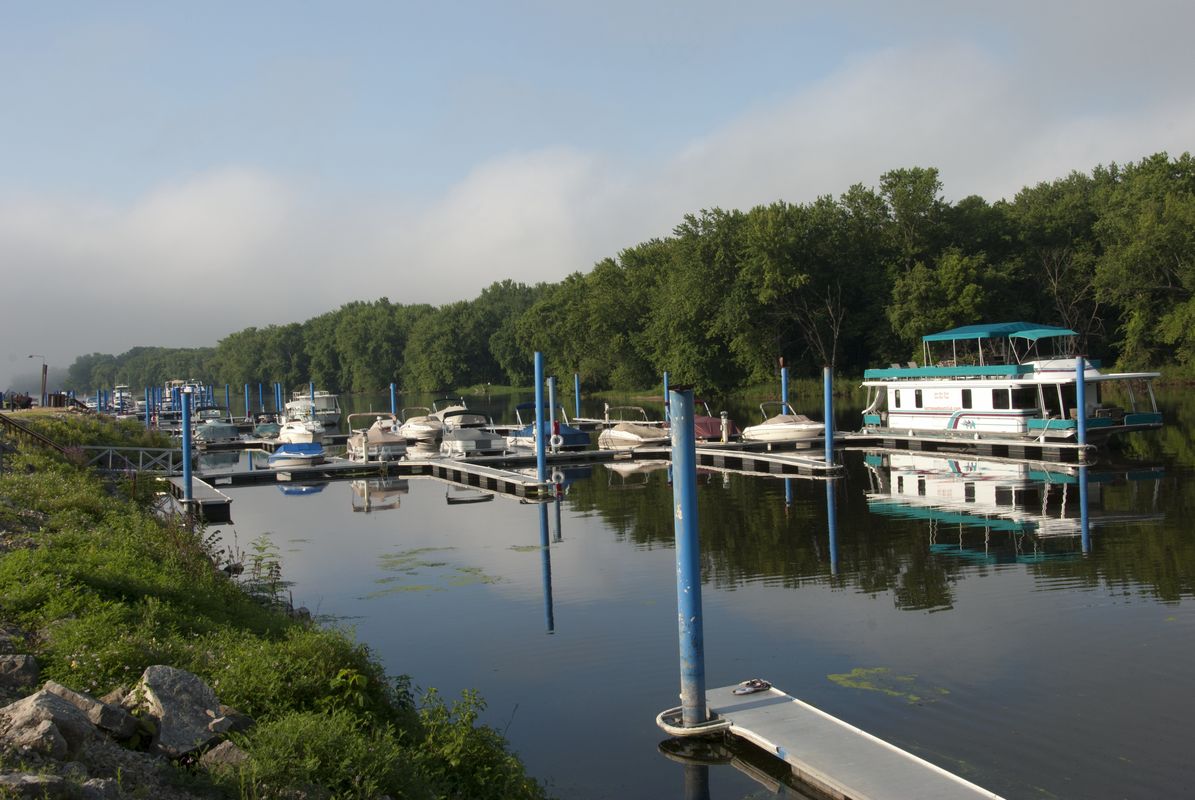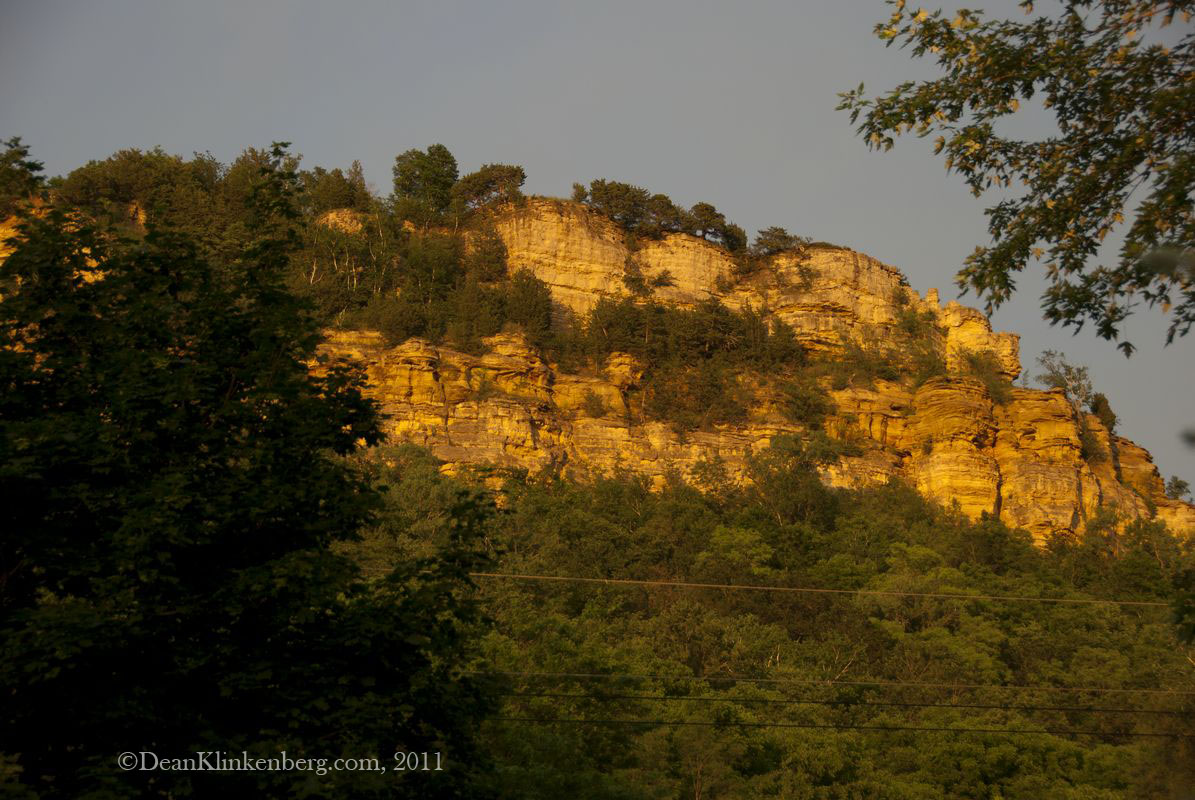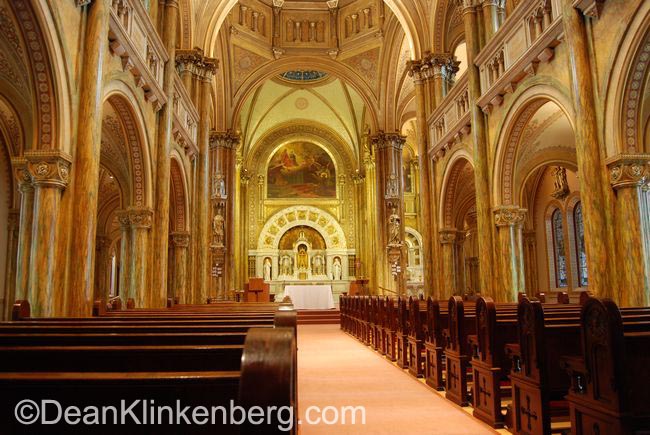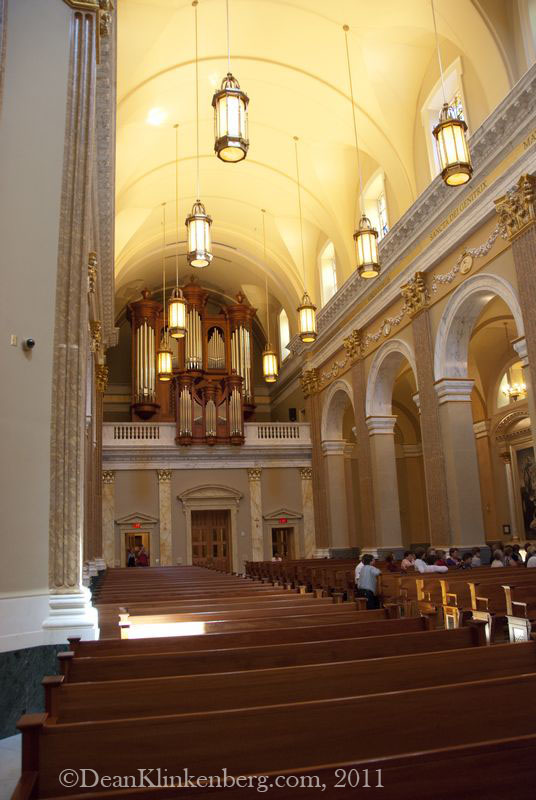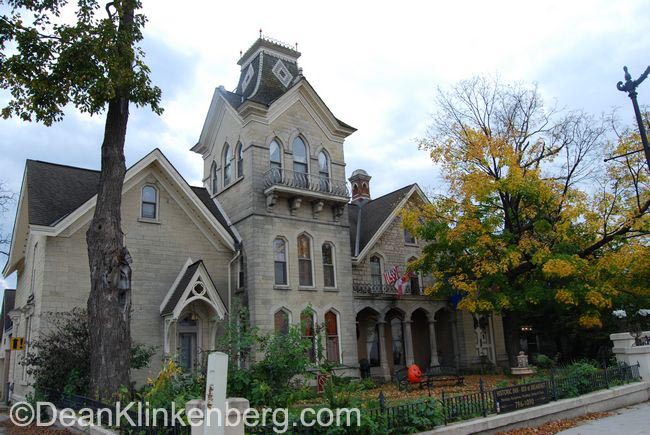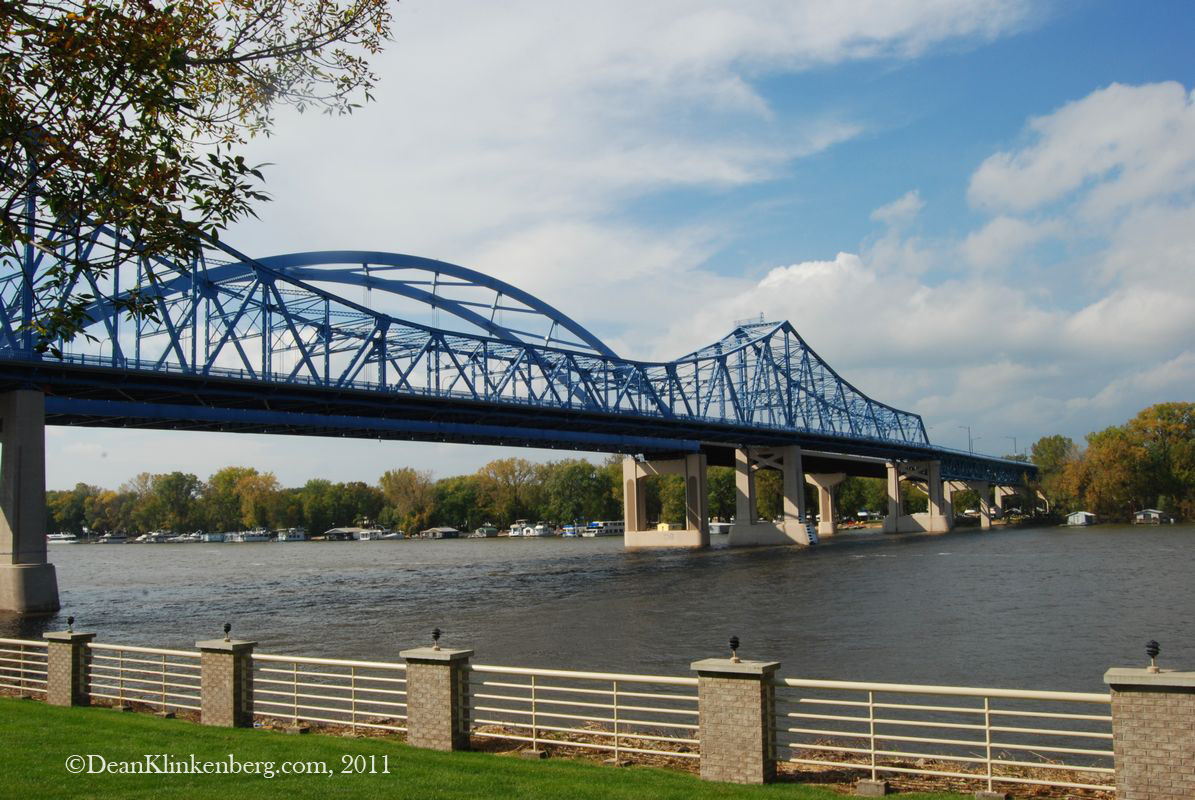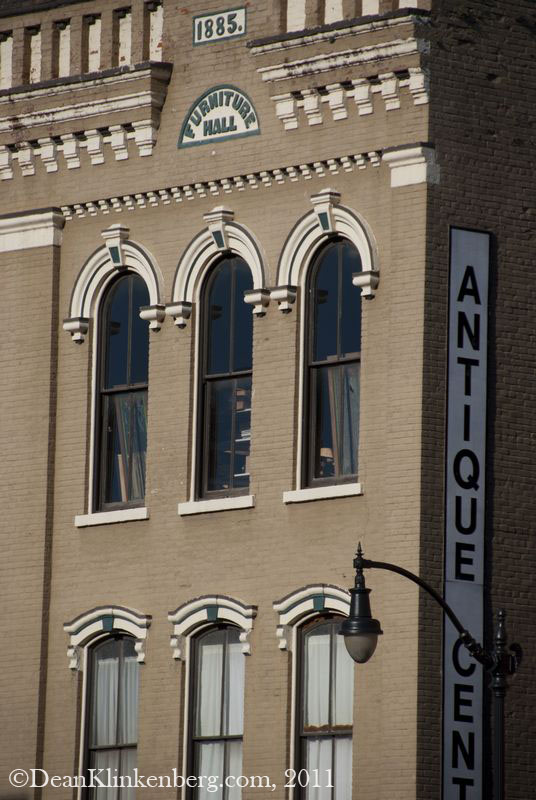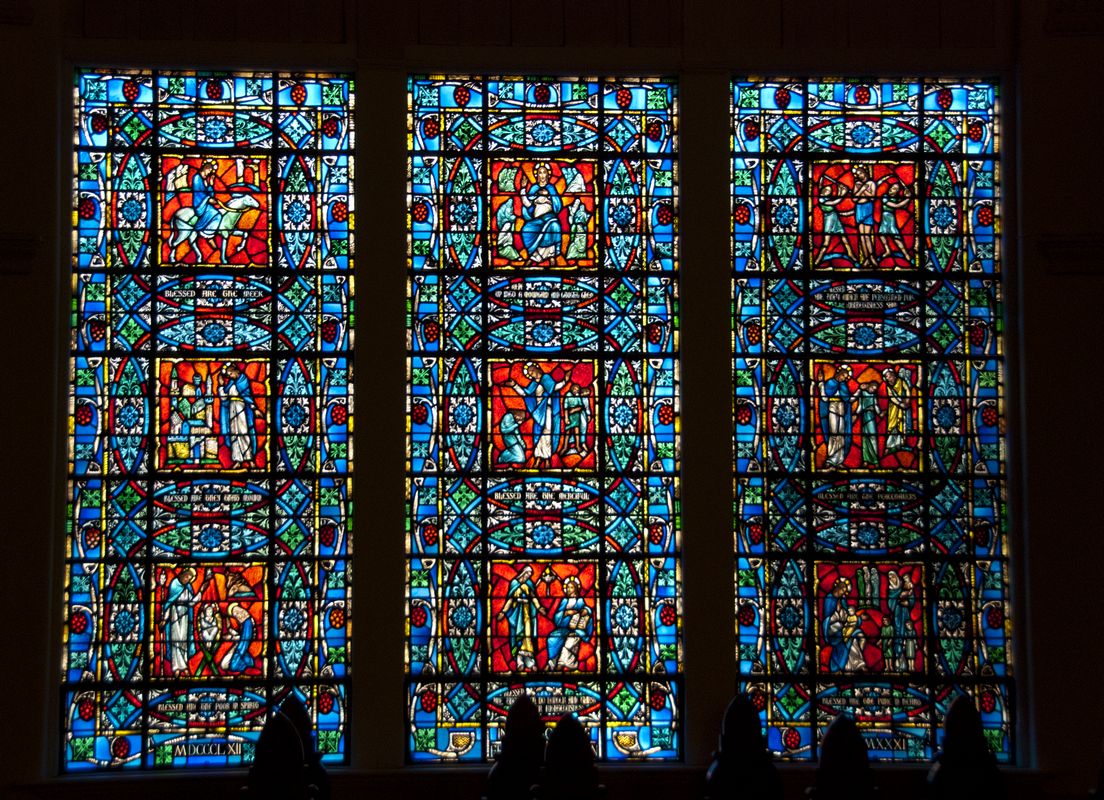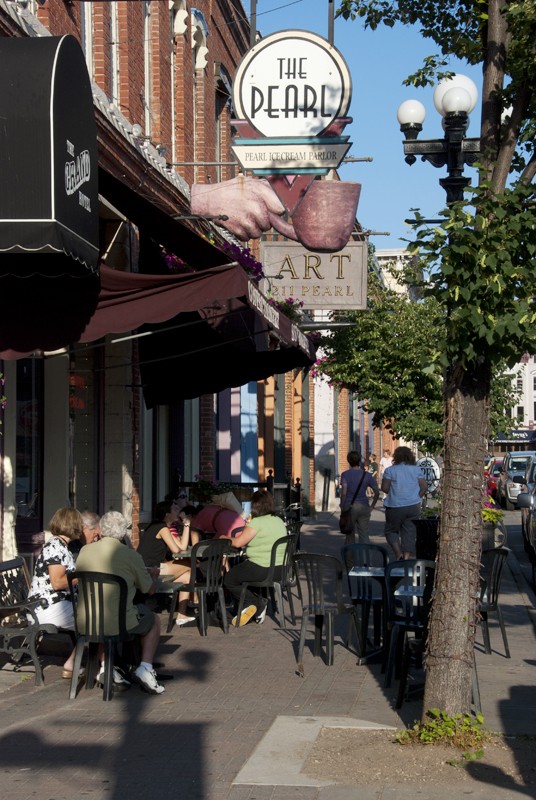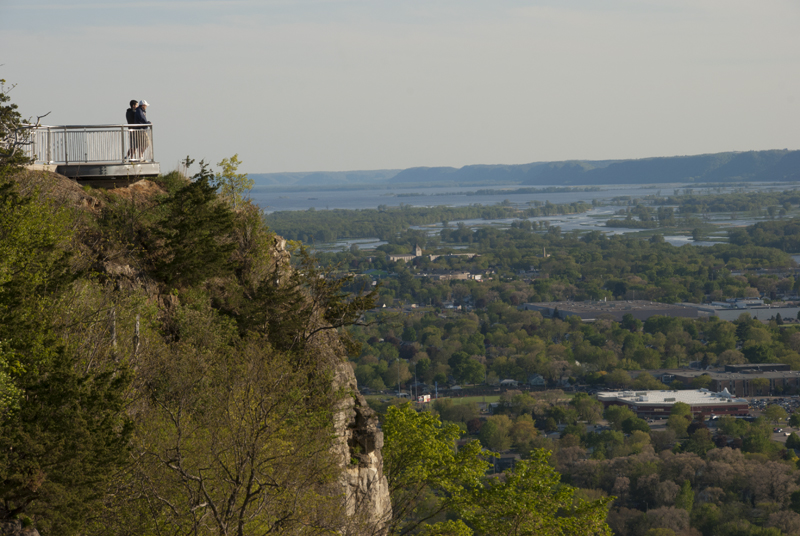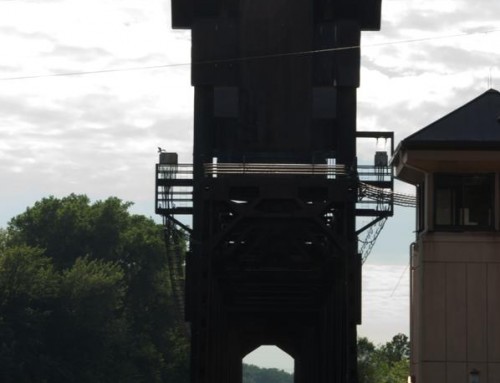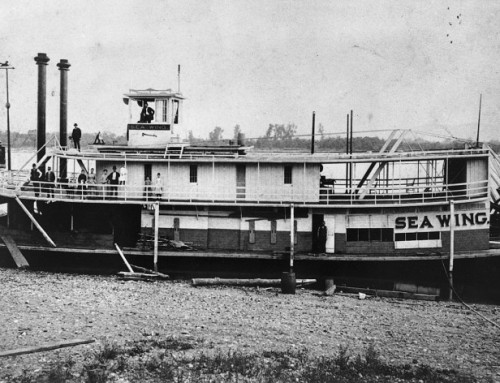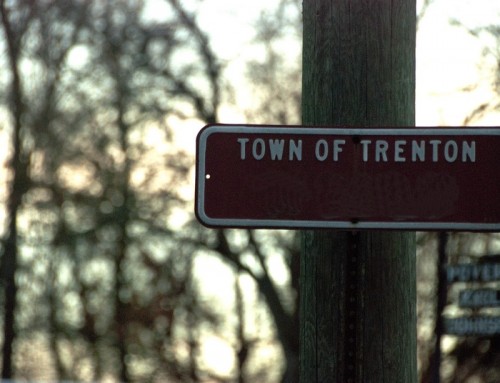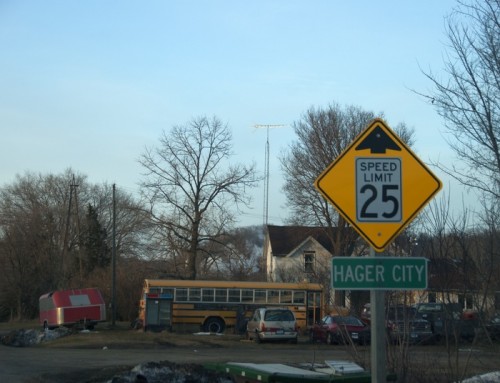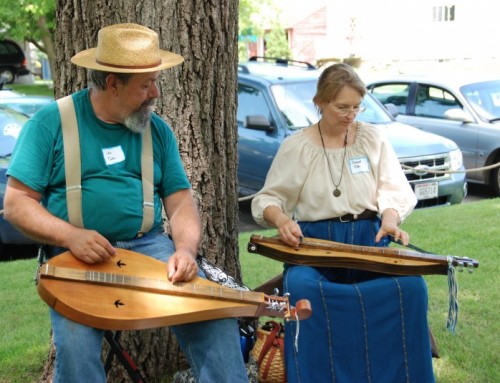Introduction
I’m not the least bit objective about La Crosse, and I won’t pretend to be. I went to college at the University of Wisconsin–La Crosse and feel in love with the city and the region. It’s the place where I learned how to live and love. And, its’s the place I first felt the draw of the Mississippi River. Even now when I return, I feel great affection for the city and still consider it one of my favorite places. Stick around for a few days, and you’re likely to feel the same way.
Visitor Information
Direct your questions to the good folks at Explore La Crosse (608.782.2366).
Arriving in Town
To follow the Great River Road through La Crosse, follow State Highway 35 (Mormon Coulee Road) to US Highway 14/61 as it changes names repeatedly (Mormon Coulee Road, South Avenue, 4th Street, Copeland Avenue, then Rose Street) and reunites with State Highway 35 on the city’s north side near Interstate 90. Through downtown, the Great River Road is divided into two one-way streets: 4th Street going northbound and 3rd Street heading south.
History
When Europeans began exploring the area, they found a prairie that was a popular spot for a game that they had never seen. In 1837, the Reverend Alfred Brunson described the Native American sport this way: “The game was played with a ball, thrown by a stick some four feet in length, the outer end of which was brought round into a ring, say six inches in diameter, to which is attached a bag of network made of strong thongs of some kind of skin. The parties start at a center post. The ball is thrown into the air as perpendicularly as possible, and when it comes down each party strives to catch it in the bag at the end of their stick and throw it as far as possible against the opposite party. The ball is caught up and thrown so back and forth, and the victors are those who drive it eventually and effectually by the center post on to the side of their opponents. It is a very exciting sport, and many a one gets an unlucky blow, sometimes from friends and sometimes from foes; but as no one is supposed to design it, no offense is given or insult imagined.”
Although it is not entirely clear why the French named the sport la crosse, it may be that the game sticks used by the Native Americans bore a strong resemblance to the crook carried by Catholic Bishops that was called la crozier. Regardless, the name stuck and the field where the game was played became known as Prairie la Crosse.
Random Fact: You can watch a game of lacrosse in La Crosse; it is a club sport at UW-La Crosse.
In the autumn of 1841, just six months after leaving a comfortable life in upstate New York, 18-year old Nathan Myrick was on a keelboat heading upriver from Prairie du Chien, eager to open a trading post at Prairie la Crosse. Loaded with supplies he purchased on credit from Fort Crawford, he and his partner, Eben Weld, arrived on November 4 after five days of travel. (You can now drive this stretch in about an hour.) The little village that grew up around him was initially called Prairie la Crosse, but Myrick, as the city’s first postmaster, decided to shorten the name. In October 1844, Myrick acquired some neighbors when a group of Mormons came up from Nauvoo and spent one winter in an area south and east of his trading post (that area is now called Mormon Coulee).
In 1848 when the land was finally available for sale, Myrick bought 100 acres but left town later in the year because of declining business prospects and transferred half his land to Harmon Miller. In 1850, Timothy Burns, who was elected Lieutenant Governor of Wisconsin a year later, bought Myrick’s half-share claim, then sold half of that back to Myrick a short time later. Myrick, Burns, and Miller were the original three proprietors who instigated an official town survey in 1851. When Myrick left La Crosse, the village had a handful of houses and a bowling alley where patrons used a ball made from a pine knot.
Settlers began streaming to town around 1850, attracted to its location on a flat, treeless plain high enough to avoid flooding; it also helped that the area was nearly malaria-free. Among the first arrivals was Emfin Emfinson—the area’s first known immigrant from Norway. By the end of 1853, La Crosse had 100 houses and five taverns. (La Crosse may still have one tavern for every 20 households.) A steady stream of covered wagons arrived from the East to cross the river via the ferry at La Crosse; 61 wagons crossed in a single June day in 1856. La Crosse incorporated as a city in 1856 and elected its first mayor, Thomas Stoddard, by a 216-215 vote.
La Crosse rapidly grew into a regional commercial center, fueled by industries like logging, banking, grain milling, and large scale manufacturing. La Crosse was also home to a high concentration of jobbers—wholesale businesses that supplied the retail trade and had an active ship building and repair industry. The railroads, which connected La Crosse to Milwaukee in 1858, were major employers. La Crosse also had a sizeable beer brewing industry, brewing as much product as their counterparts in Milwaukee.
La Crosse also grew through annexation. One of the most controversial moves was the annexation of North La Crosse, an incorporated city that was separated from La Crosse by a mile of swamp (and still is). North La Crosse had a number of sawmills, but the railroads and iron works were also major employers. Nearly one-third of the residents in North La Crosse were foreign-born, many of them Norwegian. The village had incorporated in 1868, but that didn’t stop annexation, which La Crosse pulled off through an act of the Wisconsin legislature on March 22, 1871; there was never a public vote. Annexation added 1494 residents, many of them disgruntled, increasing the city’s population to over 9000.
Settlers coming up the Mississippi found a growing city, with a busy steamboat landing. Among those early arrivals were a small number of blacks who passed through town in search of economic opportunity. Zacharias Louis Moss, who arrived in 1859, was among the few who made La Crosse home; he still has descendents in the area. George Edwin Taylor was another of those early black residents. Taylor was a strong advocate for labor, very active politically, and publisher of The Wisconsin Labor Advocate. He left La Crosse frustrated by racial politics and later became the first black man to receive a major party nomination for President of the US (National Liberty Party in 1904).
By the 1890s, the city’s economic growth had slowed considerably. The steamboat era ended in the 1880s, La Crosse’s grain milling industry was declining, and the last of the lumber mills would close in 1906. In response, the Board of Trade (a group of private businessmen) subsidized the construction of new factories to help transition lumber mill workers into new employment. They didn’t take many chances with their money, showing a strong preference to fund existing businesses such as the La Crosse Rubber Mills.
Anti-German sentiment stirred up by World War I ushered in a number of changes around town: Berlin Street was renamed Liberty Street; sauerkraut became “liberty cabbage”; and the German Society rebranded as the Pioneer Club. Prohibition nearly killed the local brewing industry; only the G. Heileman Company survived, by making soda water, malt extract, and near-beer products with names like Coney Island Beer and King of Clubs. The city generally did well, however, in the 1920s. Jobs from large employers like the La Crosse Rubber Works, Trane Company, La Crosse Plow Works, and auto parts manufacturing helped put enough money in people’s pockets to trigger a boom in housing construction.
As the Great Depression hit, government-sponsored programs through the Works Progress Administration and the construction of Lock and Dam 7 kept many folks afloat. In the immediate aftermath of World War II, pent-up labor-management conflict led to a series of contentious strikes. A decade later, La Crosse lost a quarter of its manufacturing jobs, a national trend that accelerated in the 1970s and 1980s. Ethnic Hmong began arriving from Laos in the late 1970s; many fought alongside US soldiers in Vietnam but were left to fend for themselves when the US withdrew. Thousands migrated to the US after months or years in refugee camps.
La Crosse continues to adapt. Healthcare is now a leading employer, and education and tourism have grown in importance. The downtown area has roared back to life, and the riverfront remains a popular place to hang out.
Exploring the Area
Central La Crosse
Lumber baron Gideon Hixon built a palace for him and his family in 1859, which is now preserved as the Hixon House Museum (429 N. 7th St.; 608.782.1980) is one of the oldest residences in the area. The Italianate mansion has been beautifully restored. The house is loaded with exquisite woodwork, a quirky Turkish sitting room. Remarkably, the house has retained most of its original furnishings.
La Crosse’s long and fascinating history is on display at the La Crosse Area Heritage Center (506 Main St.; 608.782.1980).
The Children’s Museum of La Crosse (207 5th Ave. South; 608.784.2652) offers a playful and educational experience for children up to age 12; let your kids simulate controlling the flow of the Mississippi River or build a bridge. Hands-on exhibits include a 28-foot vertical wall for the future rock climber in the family.
Christ Episcopal Church (831 Main St.; 608.784.0697) is one of the oldest faith communities in town, with a history dating back to the 1850s. The current Richardsonian Romanesque building was completed in 1898 when the congregation hoped it would become the cathedral for the region’s Episcopal population; it didn’t, but locals still got a wonderful church. The spacious interior is notable for two particular art glass windows. On the south side, the luminous window called Transfiguration of Christ was created by the Louis Tiffany Company. On the opposite side of the transept, The Beatitudes was created by the Charles Connick Studio of Boston and installed in 1933; it is one of the few church windows known to commemorate those famous verses from the Bible.
Hey, what’s that? The stone house at 410 Cass Street is the Mons Anderson House, a unique blend of Gothic Revival and Italian villa styles and the oldest building in town, dating to 1854. Anderson was born in Valders, Norway in 1830 and emigrated to the US at age 16. He settled in La Crosse in 1851 and made a very good living as a merchant; some of his business included selling boots and clothing to lumbermen. Anderson bought the house in 1861, then hired architect William Nichols to transform the house into the building you see today; the overhaul was completed in 1878. The house has a number of outstanding features, like the parquet floors and the exquisite library that is ornamented with black walnut paneling and bookshelves and a mosaic pattern in the floor. The house was operated as a bed and breakfast for a number of years but was sold in 2010; it now houses a French restaurant.
In a city that loves to drink, located in a state known for its beer, it’s only fitting that one would find the World’s Largest Six Pack (1111 S. 3rd St.). These giant storage containers hold 688,200 gallons of beer—enough beer for one person to have a six pack a day for 3351 years. Walk across Third Street to check out the statue of the legendary (and possibly mythical) Flemish King Gambrinus, the patron saint and purported inventor of hopped malt beer. The brewery complex is now called the City Brewery (1111 S. 3rd St.; 608.785.4820) but was once the headquarters for the G. Heileman Brewing Company (think Old Style and Special Export).
Elsewhere in La Crosse
It’s not on the Mississippi, but Myrick Park (2000 La Crosse St.) is a peaceful city park that borders the La Crosse River marsh and has a few Native American burial mounds, including a rare turtle effigy.
The Mississippi Valley Archaeology Center (1725 State St.; 608.785.8454) is located in a small brick building near the Cartwright student center on the campus of the University of Wisconsin-La Crosse. The center has been studying ancient civilizations in the Upper Mississippi Valley for decades. Their building has exhibits that showcase previous and current digs, plus displays about the cultural history of native populations, including their musical instruments and art.
Grandad Park (Bliss Rd.; 608.789.7533) has been a beloved local landmark nearly as long as the city has been in existence. In 1909, Norris Bachellor purchased a chunk of it and announced plans to quarry its stone. This did not go over very well. A group led by Ellen Hixon was formed and quickly began buying up adjacent property. They purchased land on the north and west slopes and donated it to the city; it is now called Hixon Forest. In 1912, the city acquired 533 acres atop the bluff for a park. Follow Main Street east; it will become Bliss Road as it starts to switchback its way to the top.
Maria Angelorum Chapel at St. Rose Convent is a hidden gem (912 Market St.; 608.784.2288; tours offered M–Sa; call ahead to reserve a spot). The rich Romanesque chapel, completed in 1906, has an Italian marble altar, pillars of onyx, dozens of Bavarian art glass windows and mosaics that incorporate mother of pearl and Venetian glass. The complex is the motherhouse for the Sisters of Perpetual Adoration, who have been praying 365/24/7 since 1878; lay volunteers fill in some shifts now.
A short drive southeast of town, the Shrine of Our Lady of Guadalupe (5250 Justin Rd.; 608.782.5440) is a new religious monument that has quickly attracted a large following. Construction began in 2001, and no expense was spared. The 100-acre site has a visitor center, votive candle chapel, outdoor Stations of the Cross, and a striking Romanesque shrine church. Go through the visitor center to begin the ten-minute gentle uphill walk to the shrine; you can ride up on a golf cart, if you prefer. Guided tours of the shrine are offered every day.
Norwegian immigrants settled in many of the coulees around La Crosse; a typical Norwegian farmstead has been preserved at the Norskedalen Nature and Heritage Center (County Road PI; 608.452.3424). The Bekkum Homestead will transport you back in time to the 19th century, with a period house and outbuildings like a chicken coop and summer kitchen. The visitor center has displays on the history of Norwegian immigration to the area, the tobacco plant that was the main cash crop for generations, plus some cool antique steamer trunks. If that’s not enough, on the way back to La Crosse, stop at the Skumsrud Farm (open June–Aug.) to tour another group of 19th century buildings, including a single room log cabin that is the oldest house in the county. Allow 25 minutes to drive to the Bekkum Homestead from downtown La Crosse. Follow US Highway 16 to Coon Valley, then the signs will lead down County Highways P and PI to reach the site.
Sports & Recreation
It isn’t quite like what you may have seen in the 1970s movie Rollerball, but women’s flat track derby is back and La Crosse: the Mississippi Valley Mayhem. The action will keep you on the edge of your seat as the five-player teams roll and push and elbow their way to victory. They usually play one game a month; check their website for the schedule.
The La Crosse Loggers (Copeland Park; 608.796.9553) are a member of the Northwoods League, a summer league for college players with remaining NCAA eligibility; players do not get paid, so they can preserve their college eligibility. The atmosphere feels very much like a good minor league game.
Random Fact: La Crosse native George Coleman Poage was a gifted track star who was the first black athlete to win a medal at the Olympic Games. He won a bronze medal in the 200-meter and 400-meter hurdles at the 1904 St. Louis games. Poage was also a gifted polyglot: he could read and write five languages.
Hixon Forest (608.784.0303) is an 800-acre preserve with 13 miles of hiking trails that lead up and through the forest and to at least three overlooks. The trails are part of the River to Bluff Trail, which makes it possible to hike or bike from the Mississippi River to the bluff tops without having to cross a city street. In the winter, some of the trails are groomed for cross-country skiing or snowshoeing (you can rent snowshoes through the park office).
Mississippi Valley Conservancy (608.784.3606) manages several bluff top properties that were donated to protect them from development. The most accessible is the Hass Tract (Easter Rd.). After a moderately difficult uphill hike, you can explore goat prairies at the top and enjoy good views of the river valley.
La Crosse just may be the bicycling capital of Wisconsin. If you didn’t bring your own, you can rent from UW-La Crosse Outdoor Connections (Recreational Eagle Center, 1601 Badger St.; 608.785.8860). Once you are equipped with a bicycle, ride it along the La Crosse River State Trail (608.269.4123), a 21.5 mile bike trail from La Crosse to Sparta (daily fee).
If you’d rather relax with a swim, La Crosse has three public beaches in the summer: the Black River Beach (1400 Rose St.; 608.789.7557), Pettibone Beach (Pettibone Park; 608.789.7557), and at Goose Island County Park (County GI; 608.788.7018). If you’d rather swim in a pool, you’re in luck. The City of La Crosse Parks and Recreation Department operates three public swimming pools: Erickson Pool (2412 Losey Blvd.; 608.791.8918), Memorial Pool (1901 Campbell Rd.; 608.791.8918), and North Side Community Pool (1450 Liberty St.; 608.791.8956).
In winter, the city has a number of outdoor skating rinks. If you want to skate indoors, head to the Green Island Ice Arena (2312 7th St. South; 608.789.7199; mid-October–February).
If you prefer something more vertical, take your skis or snowboard to Mount La Crosse (N5549 Old Town Rd.; 608.788.0044).
Wrench and Roll Collective (1200 Calendonia St.; 608.406.2261) rents bicycles.
Random Fact: From January 17 to the end of February, 1936, La Crosse had exactly two days with a temperature above 0° F. A few months later, residents suffered through nice consecutive 100° F days in July. This is what you call a highly variable climate.
Random Weird Fact: On July 8, 1938 an invasion of June bugs piled 18-30” deep under the lights on the Mississippi River wagon bridge; the city used snowplows to clear them.
Culture & Arts
The Pump House Regional Arts Center (119 King St.; 608.785.1434) hosts rotating exhibits highlighting regional art with an occasional national show; they have a theater on the second floor to showcase performing arts.
The La Crosse Symphony Orchestra (608.783.2121) plays several concerts a year, generally from October to April, at the Viterbo University Fine Arts Center (929 Jackson St.).
For live theater, check out the schedule at the La Crosse Community Theater (428 Front St.; 608.784.9292); they perform seven shows each year from September to June. And, don’t forget to check the schedules for theater productions at Viterbo University (Fine Arts Center; 608.796.3100) and UW-La Crosse (Toland Theater, 16th and Vine Sts.; 608.785.8522).
Parks Along the Mississippi River
North of downtown, Copeland Park (Copeland Ave. @ Clinton St.; 608.789.7533) runs along a section of the Black River; the restored steam engine Alice the Goon is located at the northern end.
Riverside Park (State St.; 608.789.7533) is a great public space, popular for hanging out and watching the sun set. Also check out the International Friendship Gardens, which is just east of the Visitors Center.
Directly across the Mississippi from Riverside Park, Pettibone Park (608.789.7533) takes up part of Barron Island. The island was part of Minnesota when Alzono Barron sketched plans for Island City, a planned development that never happened. In 1901, lumber baron (and former mayor) A.W. Pettibone purchased the entire 200-acre island and donated it to the city for use as a park. In 1918, the US Congress approved a land swap in which Minnesota gave Barron Island to Wisconsin in exchange for an island in Pierce County. Like its neighbor across the river, the park is a popular place to picnic and hang out.
Goose Island County Park (County Road GI; 608.788.7018) is a 700-acre county park with excellent facilities and numerous places for wildlife viewing, fishing, and relaxing.
Getting on the River
The La Crosse Queen (608.784.2893) is a replica of a 19th century paddlewheeler that cruises from Riverside Park. They offer a variety of cruising options: a 90-minute sightseeing cruise (from Memorial Day–Oct.), weekend dinner cruises, and a Sunday brunch cruise.
Goose Island County Park (County Road GI; 608.788.7018) has a signed seven-mile canoe trail that will require some effort to complete, given that part of the route is upstream.
The La Crosse River Water Trail is an easy 3½ mile paddle on a tributary of the Mississippi. Begin at County Highway B just one-quarter mile west of its intersection with Highway 16 and follow it to a point just above the river’s confluence with the Black and Mississippi Rivers in Riverside Park.
Tours
You may not get a chance to tour the old brewhouse for the City Brewery, but don’t fret. Head over to Pearl Street Brewery (1401 St. Andrew St.; 608.784.4832) on the first Saturday of the month (2:30pm or 4:30pm) they’ll show you how they make beer ($10).
Entertainment and Events
Farmers Market
La Crosse hosts farmers markets at Bridgeview Plaza (2500 Rose; Wed from June–Oct.) and Cameron Park (5th and King Sts.; Fri evenings, Sa mornings from May–Oct.).
Festivals
If you’re in the mood for a cold swim in early March, head to Pettibone Beach for the annual Polar Plunge, the event where otherwise reasonable people strip down and dive into a very cold Mississippi River. At least it’s for a good cause: the Special Olympics.
La Crosse’s major summer festival is Riverfest (608.782.6000), which happens the week of July 4th at Riverside Park; join the crowds for food, music, and fireworks.
In August, La Crosse hosts the Great River Folk Festival (608.784.3033; UW-La Crosse).
Ah, but the the granddaddy of La Crosse festivals is Oktoberfest (608.784.3378), and it is one helluva party that is so big it spans two weekends, attracting tens of thousands of visitors. Expect to find a lot of happy people, occasionally a few that are too happy, and enjoy the pomp, parades, and bratwurst. If you are planning to visit La Crosse either weekend, book your room well in advance, or you’ll be driving an hour from town to find a place to stay.
Live Music
In the 19th century, La Crosse residents enjoyed the music of German brass bands, a cornet band, choral music, church choirs, light opera, and a Norwegian men’s choral group called Normanna Saengerkor. You probably won’t find any of those today, but the city still has some good options to get your music fix.
For a laid-back experience, the lounges at the Waterfront Tavern (328 Front St.; 608.782.5400) and Piggy’s Restaurant (501 Front St. South; 608.784.4877) have live jazz on many evenings.
The Root Note (115 S. 4th St.; 608.782.7668) is another laid-back option for live music. Check the schedule to see what’s going on.
**La Crosse is covered in Road Tripping Along the Great River Road, Vol. 1. Click the link above for more. Disclosure: This website may be compensated for linking to other sites or for sales of products we link to.
Where to Drink
La Crosse has a reputation as a hard-drinking town and, frankly, it’s difficult to argue the point, especially after a drive down Third Street any night after 10pm. Although downtown bars draw a wide range of people, many cater to the college crowd. Not that you wouldn’t be welcome; you would. Just don’t expect a lot of high-brow entertainment. Here are a few bars around town that stand out from the rest.
Pearl Street Brewery (1401 St. Andrew St.; 608.784.4832) is based in the former La Crosse Footwear building. Visit the tasting room and enjoy beer right from the source.
For another take on local craft beer, check out the cozy Turtle Stack Brewery downtown (125 2nd St.; 608.519.2284), which has as many as nine different beers on tap at any given time.
The Bodega Brew Pub (122 S. 4th St.; 608.782.0677), located in the storefront that has had a café since 1875, is a must stop if you love quality beer; they have over a dozen on tap and 400+ in bottles.
The Starlite Lounge (222 Pearl St.; 608.796.0905) has a 1950s vibe and is the hip place for martini lovers; they host live jazz a couple of times a week.
Sitting at the top of the road to Grandad Bluff, the Alpine Inn (W5717 Bliss Rd.; 608.784.8470) is a fine place to stop for a drink, especially if you brought a designated driver.
For the latest word on the GKBTQ scene, stop into the The Center: 7 Rivers LGBTQ Connection (230 6th St. South; 608.784.0452). Gay bars include the neighborhood taverns My Place (3201 South Avenue; 608.788.9073) and Chances R (417 Jay Street; 608.782.5105).
Where to Eat
The food scene in La Crosse has improved a lot since the 1980s when I lived there. While you’ll still find plenty of good pizza and steak options, there’s a wider range of culinary diversity than there used to be and some excellent chefs at work.
Coffee Shops
It’s a college town, so there are good places to catch a caffeine buzz. Jules Coffee House (327 Pearl St.; 608.796.1200) also has good soup, beer, and wine and the added bonus of being connected to Pearl Street Books.
Get your coffee drink of choice at Grounded Specialty Coffee downtown (308 Main St.; 608.784.5282) and enjoy it on the lovely patio.
The Root Note (115 S. 4th St.; 608.782.7668) offers the standard coffee drinks, plus they have a vegetarian menu that emphasizes sustainable food products, local wine and beer, and a funky atmosphere in an historic downtown commercial building that is decorated with the work of local artists.
Bakeries/Breakfast
Stop at Meringue Bakery & Café (313 Main St.; 608.519.2683) where you can get a delicious eclair or a slice of raspberry chocolate mousse cake from chef Jen Barney—a two-time winner of baking competitions on the Food Network—and pair it with cafe au lait or caramel hot chocolate.
For a traditional diner breakfast, head to deep south La Crosse for Rosie’s Café (2225 16th Street S.; 608.788.9004) where you can fill up on a breakfast skillet, cinnamon roll, and waffles.
Light Fare
Pickerman’s (327 Jay St.; 608.782.7087) is a good choice for freshly made soup and sandwiches on bread baked in-house; they have at least six soups available every day.
The Bodega Brew Pub (122 S. 4th St.; 608.782.0677) makes lighter fare like sandwiches and soup and is a good late-night option.
The People’s Food Coop (315 5th Ave. S.; 608.784.5798) specializes in organic and locally-produced foods but they also have a number of delicious ready-to-eat foods prepared fresh every day; the impressive salad bar may be the best bargain in the store.
Hmong’s Golden Eggrolls (901 State St.; 608.782.0096) offers a taste of southeast Asia, with steaming bowls of pho, curries, and the delicious namesake eggrolls.
Piggy’s Restaurant (501 Front St. South; 608.784.4877) is a local landmark, and, while many folks opt for an evening of expensive dining, I think the best bet is to go there for lunch (11a–2p) and go hog wild at the impressive salad bar, which is loaded with fresh ingredients, plenty of green lettuce and spinach (not a hint of iceberg to be found), and made-from-scratch soups and salad dressings; add a half-sandwich for just a little more and take it with you for your next meal. Reservations are a good idea.
Taqueria Pato Azul (127 4th St. S; 608.519.3036) showcases a creative take on Mexican cuisine, tacos, especially. This isn’t the standard Mexican-American fare. The food, fresh and rich, goes in new directions, like duck carnitas. Expect a wait on weekends.
Hearty Options
Rudy’s Drive-In (1004 La Crosse St.; 608.782.2200; open daily from March–Oct.) is a classic and still a local favorite and not just for the servers on rollerskates. You can splurge on a big burger made to order and add a basket (fries and cole-slaw) for a bit more; wash it down with a draft root beer.
Buzzard Billy’s (222 Pearl St.; 608.796.2277) serves Cajun food that is tasty and usually has a nice kick. Choose from traditional dishes like red beans and rice, jambalaya, or blackened catfish or go with a po’boy for a more affordable option.
Huck Finn’s On the Water (127 Marina Dr.; 608.791.3595) is set on a bay on the Black River, with something of a Key West vibe, next to a marina where you can stare at the big boats and wish you had one. The menu includes steak and fish like catfish and walleye. The lunch menu has a number of more affordable options, mostly sandwiches .
Fine Dining
Author’s Pick: Lovechild (300 3rd St. S; 608.433.2234) is a breath of fresh air in the fine dining scene. The interior blends a retro-modern sensibility between exposed brick walls in an old storefront, while the menu features creative dishes built from seasonal ingredients. It’s a great place to relax and feel spoiled.
The Waterfront Restaurant and Tavern (328 Front St. South; 608.782.5400) offers a number of sophisticated entrées that change with the seasons; a winter menu when I visited was seafood-heavy and included coconut-curried mussels, a meat-free Corsican linguini, prosciutto-wrapped pork tenderloin, steaks, and lamb; lunch is served during the week (M–F 11–2:30) with a wide selection of sandwiches, salads, and soups.
The Freight House (107 Vine St.; 608.784.6211) is a popular choice for high quality steaks and seafood in a historic 1880-era railroad warehouse that can get a bit loud; choose from among ten different steak entrées, as well as pork chops, chicken, and vegetarian entrées; seafood entrées like king crab legs, salmon, and lobster can be ordered as half or full orders.
When I walked into Digger’s Sting (122 3rd St. N.; 608.782.3796), I expected to bump into Vito Corleone; the dark interior suggests 1940s gangster chic. Locals love the prime rib, but they prepare a range of other meat-centric entrées like beef tenderloin, baby back ribs, and chicken marinara or you can opt for the less expensive salad and sandwich options. Did I mention the mushrooms? Oh, those mushrooms…
The Charmant Hotel downtown (101 State St.; 608.519.8800) has several options to please your palate and improve your well-being. If the weather is nice, head to the rooftop lounge for a cocktail and a snack. The restaurant serves food inspired by rustic French cuisine and does so all day every day. The relaxed atmosphere of the Parlour is a great place to enjoy a cappucino and croissant in the morning or a glass of wine in the evening.
Ice Cream
La Crosse can help you with that ice cream fix, too. The Sweet Shop (1113 Caledonia St.; 608.784.7724) is an old-fashioned ice cream parlor, the kind where they still make their own ice cream and have since 1921 and you can get one of those old-fashioned sodas with fizzy water. Oh, they also make chocolates.
The Pearl Ice Cream Parlor (207 Pearl St.; 608.782.6655) is another old-fashioned soda fountain where they make their own ice cream enjoy it in a double scoop in a waffle cone, a root beer float, or a banana split. The line often extends onto the sidewalk in summer. They also run a chocolate shop next door.
And, let’s not forget Ranison Ice Cream (706 16th St. South; 608.782.1987), a charming neighborhood shop with deep roots in the area that also makes it own ice cream.
Where to Sleep
Reminder: If you are going to be in La Crosse for OktoberFest, you should book a room well in advance.
Camping
Goose Island County Park (W6488 County Road GI; 608.788.7018) packs in the campers in its 400 sites; don’t expect spacious, private sites, but the area is beautiful and many sites are next to the river.
Pettibone Resort (333 Park Plaza Dr.; 800.738.8426/608.782.5858) is another large campground, this one in the floodplain along the backwaters; sites have plenty of shade but not much space.
Budget
Welch Motel (3643 Mormon Coulee Rd.; 608.788.1300) has a 1950s vibe, especially on the exterior, with 16 tidy rooms that have been updated.
Bed-and-Breakfast Inns
The restored and updated Cargill-Pettibone House (145 8th St. S; 608.519.3101) rents four beautiful suites in a historic Italianate mansion near downtown. They offer four rooms, all with bathrooms en suite, and there’s plenty of space to spread out.
A beauty of a Victorian mansion, the Bentley-Wheeler Bed and Breakfast (950 Cass; 608.784.9360) rents three suites and an old guest house. Each unit is equipped with luxury details, such as high thread count sheets and LCD televisions. The rate includes a continental breakfast.
For a taste of life like royalty, spend a night or two at the Castle La Crosse Bed and Breakfast (1419 Cass St.; 844.726.5808), a monumental mansion that dates to 1891. The four guest rooms, are loaded with luxury touches, including fine linens, marble countertops, en suite bathrooms, and a full breakfast.
Houses
The Wilson Schoolhouse Inn (W5718 Highway 14-61; 608.787.1982) is another distinctive place to stay. The former brick schoolhouse, built in 1917, has been converted to a gorgeous and comfortable inn, with a spacious living room bathed in generous amounts of natural light and some original features left intact (like part of the a chalkboard). The inn has two bedrooms, two bathrooms, and a modern kitchen and could sleep up to eight guests). The inn is easy to miss, because it is shielded by a row of evergreen trees.
You won’t find a more unique place to stay than the Bluff View House (751 22nd St. N.; 608.317.4311). Built in 1949, this is one of only 2499 Lustron pre-fab all-metal houses built in the US and one of about 1600 left. The two-bedroom house has a full bath, full kitchen, washer and dryer, garage, and bicycles available for guests.
Moderate and up
There are two chain hotels that have rooms on the downtown riverfront. The Radisson Hotel (200 Harborview Plaza; 608.784.6680) is a high-rise hotel with 169 rooms that is popular with wedding parties; the rooms on the west side have river views.
The Courtyard by Marriott (500 Front St.; 608.782.1000) is further south in a cluster of newer riverfront buildings; the hotel has 78 rooms, some with river views.
For a taste of the high life, spend a night or two at the Charmant Hotel (101 State St.; 608.519.8800); once a candy factory, the building has been transformed into an impressive luxury hotel.
Getting There
The train station is on the north side under the Rose Street viaduct (601 Caledonia; 800.872.7245). Amtrak’s Empire Builder and Borealis trains stop in La Crosse. The Empire Builder runs between Chicago and Seattle, with stops along the Mississippi River at La Crosse, Winona, Red Wing, Saint Paul, and St. Cloud. The Empire Builder often runs late. Westbound Empire Builder trains (to Seattle) have a scheduled departure time of 8:04pm, while eastbound Empire Builder trains (to Chicago) have a scheduled departure time of 11:37am. Borealis trains connect Saint Paul and Chicago, with stops along the Mississippi at La Crosse, Winona, Red Wing, and Saint Paul. Northbound trains have a scheduled departure time of 3:58pm, while southbound trains have a scheduled departure time of 2:16pm. Fares are based on the number of available seats and therefore vary considerably; in general, the earlier you book, the cheaper the ticket will be.
Jefferson Lines (800.451.5333) operates regional bus service. Schedules and fares are so damn confusing and change so often, you are better off just calling them directly for the most current info. What I can tell you is that the cheapest rates are for 21-day advance purchase, especially for travel Su–Th. Buses board downtown (314 Jay St.) and seasonally at UW-La Crosse (Student Union, 521 East Ave. N.). If you are buying tickets at the last minute, check fares for Amtrak, too.
La Crosse Regional Airport is north of downtown on French Island (608.789.7464); it is served by American Airlines and Delta. There is no taxi stand; use the phones across from the rental car counter to call for one. There is also bus service to the airport through MTU bus route #7, but it is not very convenient. Buses only run M–F during the day and to reach downtown La Crosse, you must transfer at the Clinton/Caledonia stop to route #6.
Getting Around
Bus service is provided by the La Crosse MTU (608.789.7350; operating hours vary by route). Each bus has a bike rack with space for two bikes (no additional charge). Later at night, free rides are sometimes offered from the downtown bars to campus locations.
Resources
The La Crosse Tribune (608.782.9710) is the local daily newspaper.
Downtown post office: 425 State St.; 608.791.8100.
La Crosse Public Library: 800 Main St.; 608.789.7100.
Public Radio Station: 90.3, WHLA.
Where to Go Next
Heading upriver? Check out French Island.
Heading downriver? Check out Stoddard.
Community-supported writing
If you like the content at the Mississippi Valley Traveler, please consider showing your support by making a one-time contribution or by subscribing through Patreon. Book sales don’t fully cover my costs, and I don’t have deep corporate pockets bankrolling my work. I’m a freelance writer bringing you stories about life along the Mississippi River. I need your help to keep this going. Every dollar you contribute makes it possible for me to continue sharing stories about America’s Greatest River!
La Crosse Photographs
A Song for La Crosse
Rivertown by Mr. Blink, from Free and Loafing in La Crosse (2009)
©Dean Klinkenberg, 2024, 2021, 2018,2013,2011


